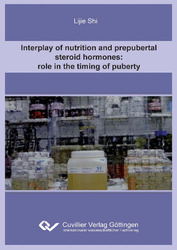| Departments | |
|---|---|
| Book Series (96) |
1379
|
| Nachhaltigkeit |
3
|
| Gesundheitswesen |
1
|
| Humanities |
2367
|
| Natural Sciences |
5407
|
| Mathematics | 229 |
| Informatics | 319 |
| Physics | 980 |
| Chemistry | 1364 |
| Geosciences | 131 |
| Human medicine | 243 |
| Stomatology | 10 |
| Veterinary medicine | 108 |
| Pharmacy | 147 |
| Biology | 835 |
| Biochemistry, molecular biology, gene technology | 121 |
| Biophysics | 25 |
| Domestic and nutritional science | 45 |
| Agricultural science | 1004 |
| Forest science | 201 |
| Horticultural science | 20 |
| Environmental research, ecology and landscape conservation | 148 |
| Engineering |
1793
|
| Common |
98
|
|
Leitlinien Unfallchirurgie
5. Auflage bestellen |
|
Advanced Search
Interplay of nutrition and prepubertal steroid hormones: role in the timing of puberty (English shop)
Lijie Shi (Author)Preview
Table of Contents, Datei (33 KB)
Extract, Datei (79 KB)
Background and aim
Adrenarche and puberty are two important events in human’s growth and maturation. Children with premature adrenarche or precocious puberty are at risk for the development of hormone-related cancers or chronic disease later in life. Childhood nutritional status has been suggested to be associated with pubertal timing, whether it is also relevant for adrenarche (the increase in adrenal androgen production) is not clear. Excess adrenal androgen, glucocorticoid, and estrogen exposures can influence somatic growth and sexual maturation. The evidence for the role of them in the physiological range in pubertal timing is limited. This thesis aimed to examine whether body composition and certain dietary intakes may influence adrenal androgen production and whether prepubertal adrenal androgen, glucocorticoid, and estrogen status are associated with early and late pubertal markers in healthy children, independent of nutritional status. Data came from the prospective DOrtmund Nutritional and Anthropometric Longitudinally Designed (DONALD) Study, which observes diet, growth, and metabolism in healthy children from birth until young adulthood.
Results
Four consecutive analyses (Studies I-IV) were performed. In Study I (n=137), among all the examined anthropometric (fat mass and fat free mass) and dietary (protein, fat and fiber intake, glycemic index and load) factors, only fat mass and animal protein intake were positively associated with AA-secretion and explained 6% of total AA variation even after accounting for the indices of major steroidogenic enzyme activities. Although animal protein intake and AA secretion were associated with each other, Study II (n=109) showed that the negative associations of AA secretion with ages at Tanner stage 2 for breast (B2, girls), genital (G2, boys) and pubic hair (PH2, boys and girls) development were independent of animal protein intake and the negative associations of animal protein intake with the start of pubertal growth spurt (ATO) and age at peak height velocity (APHV) were independent of AA. Children with a higher AA secretion had a 1.5 yrs earlier begin of PH2, a 0.8 yrs earlier begin of B2_G2, and 0.2 yr shorter duration of pubertal growth acceleration than those with a lower one. In contrast to AA, GC secretion [Study III (n=110)] was positively associated with pubertal timing and this association seemed to be sex specific, i.e. only in girls. Girls with higher prepubertal GC secretion reached ATO 0.7 yrs later and menarche 0.9 yrs later; age at B2, PH2 and PHV tended also to occur later. In Study IV (n=120), urinary E excretions were not associated with ATO, APHV, or age at PH2, but with duration of pubertal growth acceleration in both sexes. Girls with higher E levels reached B2 0.9 yr and menarche 0.3 yrs earlier than girls with lower one. Prepubertal E production was not associated with age at G2 in boys.
Conclusions
Body fat mass may relevantly influence prepubertal adrenarchal androgen status and animal protein intake may also make a small contribution to children’s AA-secretion levels. Prepubertal variations of steroid hormones (AA, GC, and E) in physiological range appear to be differently involved in the modulation of pubertal timing in healthy children. Higher AA and E secretion may not be critical for the earlier onset of pubertal growth spurt and APHV, but precipitate a shorter pubertal growth spurt in boys and girls. In girls, higher AA or E production predicts a notably earlier onset of breast development; however age at menarche appears to be only determined by E. In boys, AA but not E is relevant for genital development. GC may influence pubertal timing of girls but not of boys. Higher GC secretion, as a marker of higher stress activity, predicts notably later onset of pubertal growth spurt and menarche. Breast and pubic hair development as well as APHV may also tend to occur later.
| ISBN-13 (Printausgabe) | 3869555378 |
| ISBN-13 (Hard Copy) | 9783869555379 |
| ISBN-13 (eBook) | 9783736935372 |
| Language | English |
| Page Number | 138 |
| Edition | 1 Aufl. |
| Volume | 0 |
| Publication Place | Göttingen |
| Place of Dissertation | Universität Bonn |
| Publication Date | 2010-11-01 |
| General Categorization | Dissertation |
| Departments |
Domestic and nutritional science
|








